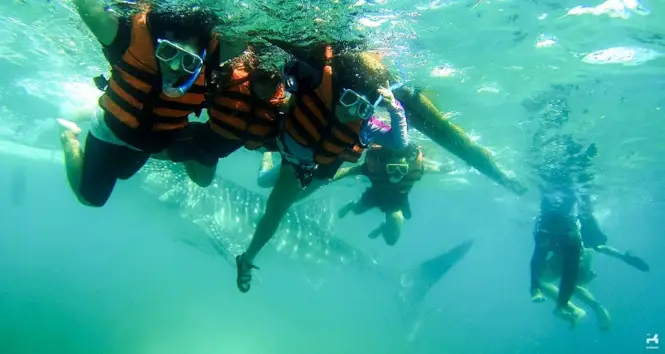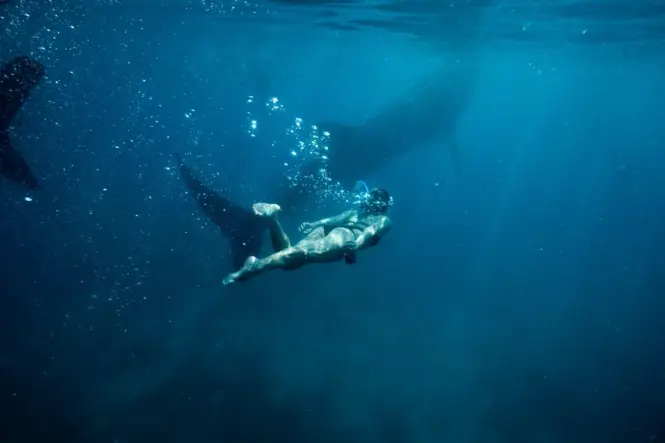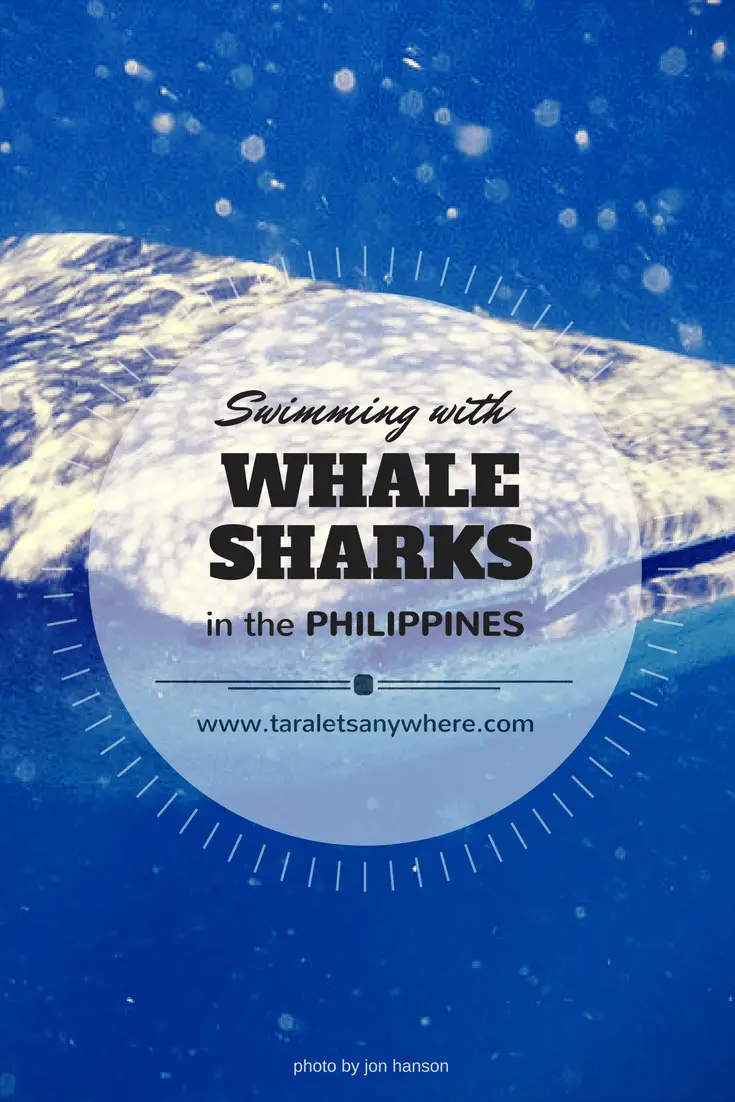
Why we don’t recommend the whale shark activity in Oslob, Cebu
Swimming with whale sharks in Oslob, Cebu, is one of the most popular adventures in the Philippines. In fact, this tourism singlehandedly put Oslob in the tourism map. People from all over the world flock here for a once-in-a-lifetime experience of swimming and taking pictures with the biggest species in the ocean.
As with other cases of wildlife tourism, there is an important ethical aspect about this activity that we should consider.
Observing and swimming with whale sharks is acceptable if done correctly. That is to stay, if the whale sharks are allowed to stay in their natural habitat and free to move according to their natural migratory cycles.
This isn’t the case in Oslob.
Here I’m going to tell you why you shouldn’t support the whale shark tourism in Oslob (Cebu) and then present a better, ethical choice.
Contents
Get to know the whale sharks
Before anything else, let’s take a quick background look at whale sharks. Whale sharks are known as the “gentle giants”. They are the largest fish in the sea, measuring up to 40 feet. They are plant-eating animals, hence the monicker.

They can be seen in a few places on earth, including Australia and select places in Asia. In the Philippines, whale sharks can be seen in Cebu, Sorsogon, Leyte and even in Palawan. Of these places, Cebu and Sorsogon have the more established whale shark tourism.
Whale sharks are locally known as butanding.
Dangers of the whale shark tourism in Oslob
The whale sharks are a big tourist attraction in Oslob. It draws hundred thousands of tourists every year and it provides income to local households.
In Oslob, the locals regularly feed the whale sharks with krills to keep them in the area. This guarantees sighting all-year round.
Here are the reasons why this practice is essentially unethical.
1. It causes injury
The local tourism enacts a regulation that instructs tourists to keep a 4-meter distance from the whale sharks. However, the animals still suffer injuries from constant rubbing with boats and contact with tourists.
People think that injury from human contact is only caused by irresponsible tourists, but this isn’t necessarily true.
We were in Oslob a few years ago, and with the enclosed space as well as the whale sharks’ tendency to swim close or beside humans, it can be difficult not to hit or get hit by them. For instance, when my friends and I were clinging to the side of the boat, paddling our feet, a whale shark swam behind us and we only realized that we’d inadvertently hit it later. Also, my boyfriend Hali took a deep dive and when he was resurfacing, he got swatted by the tail of a whale shark swimming by. While these isolated cases might not be serious, taken collectively it may take a toll on the whale sharks’ bodies.

We also read that sometimes there are as much as 100+ tourists crowding the sharks in the given 30-minute period.

2. Lack of proper nutrition
Whale sharks become accustomed to being human fed that they automatically associate human presence with food. This makes them easy bait for shark hunters or conditions them to come close to any boat, which is dangerous if the boats sport propellers.
The whale sharks are also not fed enough by the locals. Since the whale sharks miss out on the nutrients from various plankton growing in other areas, they suffer from lack of nutrition.
3. It endangers their breed
Lastly and perhaps the most important, the activity changes their natural migratory pattern. Normally, whale sharks stay in Oslob for about 60 days before moving to another location. With the regular feeding, they become mainstays in Oslob for 365 days a year. Scientists fear that this may eventually harm their breeding cycle and thus reproduction.
These are basically the important reasons why you shouldn’t partake in the whale shark tourism in Oslob, Cebu. To learn more about the effects of the Oslob whale watching tourism, head on to Dive in Bohol and LAMAVE.org.
An eco-friendly alternative
If you really want to go on a whale shark watching activity, it’s best to head to Donsol in Sorsogon Province. The community here promotes a sustainable approach and is supported by the World WildLife Fund.
In Donsol, the locals do not feed the whale sharks. Instead, they leave them in their natural habitat. Whale shark watching is done on selected months (particularly from February to April or May) following the migration pattern of the whale sharks to Donsol Bay. Tourists go on boat tours accompanied by spotters, who signals them of sightings.
There’s a small downside to this. Even during peak season, interaction is not 100% guaranteed. Resorts often advise tourists to allot 2 days for the whale shark tour in Donsol Bay. However, the most important thing is the whale sharks are left alone.
Here’s a Guide to Whale Shark Watching in Donsol, Sorsogon.
P.S. Another place where you can spot whale sharks in their normal routine is in Pintuyan in Southern Leyte.
What you can do to help
The information campaign about the whale shark activity in Oslob is an ongoing practice. Even today, there are still people unaware of its ecological effect.
In fact, we were in Oslob in 2015 and did not hear anything about it until after our trip, when I did further research for the article I was writing.
The local government continues to support this practice since it generates income and basically supports the local livelihood of about 300 people who work in the feeding site and there are no signs that it will be halted in the future.
That saying, there are still things you can do to help:
- Spread awareness about this issue
- Support alternatives such as the ethical tourism done in Sorsogon and Leyte
My personal insight is that the Philippines is a developing country and the ethical side of tourism isn’t a major concern for most people. However, over the years there are signs of growing awareness and it gives me hope that we can still make a difference.
What to read next:
Visiting Cebu? Here are other posts you might be interested at:
- Day Tour in Oslob
- Day Trip in Moalboal and Kawasan Falls
- Travel Guide to Moalboal
- Travel Guide to Bantayan Island and Top Things to Do in Bantayan Island
- Travel Guide to Malapascua Island
Looking for accommodations?
Further reading on sustainable tourism:
If you like this post, save it in Pinterest!


Katherine Cortes is a long-time backpacker and a freelance writer/editor. She likes beaches, snorkeling trips, and relaxing staycations (preferably with bath tubs!).



22 Comments
Erwin
Whale shark watching is truly a rare experience but we need to be responsible and take care of the whale shark. We need to study more if this activity is causing harm or helping the whale sharks. We need to get more input on how to really make this activity nature friendly as well as a great experience.
Katherine Cortes
Erwin, I’m disgusted that you talked about responsibility and linked to a whale shark tour at the same time. I deleted your link.
Aysa
I fully support you on this. They should not rely on human beings for food. They should be out on the wild.
Inhinyera Lakwatsera
I super agree. When we were in Oslob, I’m excited at first but when I was there, seeing what really “swimming with whale shark” is, makes me feel bad for the whale shark.
The locals should make a step to limit the crowd.
Kevin Wagar
Excellent information. We are heading to the Philippines in a few months and have been wary of which outfits we would use to see whale sharks due to the bad reputation and feeding practices that so many seem to have.
nicolepaler
I didn’t know about this until I read your post. Never thought that “Manila Zoo” is happening on an underwater level. I wish that they would not do the feeding part, and let the whalesharks be. There are always other means of income. And it’s not good if tourism will harm the environment sooner or later. Parang boracay lang. 🙁
Louisa Mercado (@2livelovelaugh5)
I wasn’t aware of the dangers to the whale sharks. It’s sad to know that this is happening and it’s being done to earn from. It should be put to law somehow how marine life is treated. It’d be sad to know that one day they become endangered.
Eloise - MyFavouriteEscapes.com
Thanks for sharing your experience. I just saw photos on Facebook of friends swimming with the whale sharks in the Philippines and thought it would be awesome. Now I know how not to do it.
Alyssa J
I was in Cebu and couldn’t justify on swimming with the whale sharks in Oslob (the environmentalist in me cringe…) but glad there is an alternative!
Also, quick hello from FTB! I’ve been guilty of stalking your blog and found it really helpful for my trip to the Philippines!
Katherine
Thanks so much, Alyssa! 🙂
MeanderWithMeg
Thanks for sharing this information, I think it will hopefully make a lot of people stop and consider their actions. I wouldn’t feel comfortable encouraging the feeding of wild animals for tourism, so I agree with you there!
Stargazer Writes
Oh, I have tried diving with the whale sharks in Oslob. That was 4 years ago. After reading this, I now feel guilty. I never gave it much thought, on what bad things that can happen to them. For me, as long as I see that they are swimming in open waters, I’m good. But now, thinking about it and after ready your post, everything I believed in has changed. Thanks for opening my eyes.
Katherine
Yeah, me too. We were there 2 years ago and before our trip we hadn’t read or heard anything about this issue. I think it’s really important to spread this info and educate others so we can have an informative choice on which attractions to visit.
Thelittlelai: Beyond limitsl
This is really the reason why I didn’t even try to go to Oslob and have a close encounter with whale shark. I don’t see any reason to do it because of the wrong way of treating them. I hope the Government of Oslob and Cebu will do something about this. This has long been an issue and yet the operation is still on-going even up to this time. I even fought with my friends regarding with this one, cause I tried to stop them to visit Oslob and swim whale shark. It is really heart breaking knowing that there are still people who don’t practice responsible tourism.
Katherine
People are divided and I think a lot are in denial because of the income it generates for Oslob. I’m actually surprised I’ve yet to see a disagreeing comment on this one.
beadmania
I can recommend the Whale shark nature foundation on leyte.
We do this trip with Erhard from “whale shark divers” leyte . It is like roulette game . may be you got one – may be not 🙂 . But it is strictly observed by the foundation that not too much people go there . The spotters (which are fishermen before) get a new job there . They go with small boats and snorkeling glasses for looking if there are whale sharks present. If yes , the tourist boats which have to wait outside get informed and are allowed to come thru quiet and slowly . All snorkeling is observed from staff of the nature foundation . It was a great trip, because we are lucky and had 3 Whale sharks this day.
Katherine
Wow, thanks for the tip! I read about whale sharks in Leyte but there isn’t much info in the net then.
ANNE
Great article! Thanks for educating us on the disadvantages of Oslob tourism. I hope the whale sharks of Cebu will be protected by the same people that make money from them
wheninmyjourneys
I was in Cebu last March and I stayed in Oslob for 5 days but I didn’t partake in the whale shark activity. It’s not that I was being self-righteous but I simply do not support the practice.
Adrenaline Romance
We have received offers and requests to cover the whale shark watching activity in Oslob several times. We turn them down every time because the practice is non-sustainable. It also affects their natural actions.
Claire Santiago
I also agree that whale shark tourism in Oslob should be regulated if it is not possible to be prohibited. People should not always think of money they should also think of caring for nature because nature is our source of life. There are a lot of ways to help those people who depend on tourism in the place, earn a decent living.
kapampangantraveller
I am one with you in this cause. I do not recommend friends and acquaintances to visit Oslob with its whale shark related activities. Would recommend to visit its natural attractions like the Tumalog Falls and other structures. Plus according to my friends whom been there, the water is quite “malansa” and itchy, or better alternative is Moalboal’s Sardine Run.